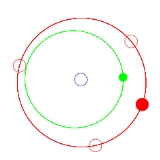
153 Hilda
Encyclopedia
153 Hilda is a large asteroid
in the outer main belt, with a diameter of 170 km. Because it is composed of primitive carbonaceous materials
, it has a very dark surface. It was discovered by Johann Palisa
on November 2, 1875 from the Austrian Naval Observatory at Pula
. The name was chosen by the astronomer Theodor von Oppolzer
, who named it after one of his daughters.
(or Hildas for short). It is not a true asteroid family
, since the members are not physically related, but rather share similar orbital elements. The Hildas are locked in a 2:3 orbital resonance
with Jupiter
; since Jupiter takes 11.9 years to orbit the Sun while Hilda takes 7.9 years, Jupiter orbits the Sun twice for every 3 orbits that Hilda completes. There are over 1,100 other objects known to be in a 2:3 resonance with Jupiter.
a star
on December 31, 2002, from Japan. It has a very low-amplitude light curve
indicating a spherical body or a non-varying albedo.
Asteroid
Asteroids are a class of small Solar System bodies in orbit around the Sun. They have also been called planetoids, especially the larger ones...
in the outer main belt, with a diameter of 170 km. Because it is composed of primitive carbonaceous materials
Carbonaceous chondrite
Carbonaceous chondrites or C chondrites are a class of chondritic meteorites comprising at least 7 known groups and many ungrouped meteorites. They include some of the most primitive known meteorites...
, it has a very dark surface. It was discovered by Johann Palisa
Johann Palisa
Johann Palisa was an Austrian astronomer, born in Opava in Austrian Silesia .He was a prolific discoverer of asteroids, discovering 122 in all, from 136 Austria in 1874 to 1073 Gellivara in 1923...
on November 2, 1875 from the Austrian Naval Observatory at Pula
Pula
Pula is the largest city in Istria County, Croatia, situated at the southern tip of the Istria peninsula, with a population of 62,080 .Like the rest of the region, it is known for its mild climate, smooth sea, and unspoiled nature. The city has a long tradition of winemaking, fishing,...
. The name was chosen by the astronomer Theodor von Oppolzer
Theodor von Oppolzer
Theodor von Oppolzer was an Austrian astronomer and mathematician.The son of the physician Johann Ritter von Oppolzer, Theodor was born in Prague, at the time part of the Austrian Empire. He completed his graduate studies in medicine at the University of Vienna, gaining a Ph.D. in 1865...
, who named it after one of his daughters.
Orbit and family
Hilda gives its name to an asteroid group called the Hilda familyHilda family
The Hilda asteroids consists of asteroids with a semi-major axis between 3.7 AU and 4.2 AU, an eccentricity less than 0.3, and an inclination less than 20°. They do not form a true asteroid family, in the sense that they do not descend from a common parent object. Instead, this is a dynamical...
(or Hildas for short). It is not a true asteroid family
Asteroid family
An asteroid family is a population of asteroids that share similar proper orbital elements, such as semimajor axis, eccentricity, and orbital inclination. The members of the families are thought to be fragments of past asteroid collisions...
, since the members are not physically related, but rather share similar orbital elements. The Hildas are locked in a 2:3 orbital resonance
Orbital resonance
In celestial mechanics, an orbital resonance occurs when two orbiting bodies exert a regular, periodic gravitational influence on each other, usually due to their orbital periods being related by a ratio of two small integers. Orbital resonances greatly enhance the mutual gravitational influence of...
with Jupiter
Jupiter
Jupiter is the fifth planet from the Sun and the largest planet within the Solar System. It is a gas giant with mass one-thousandth that of the Sun but is two and a half times the mass of all the other planets in our Solar System combined. Jupiter is classified as a gas giant along with Saturn,...
; since Jupiter takes 11.9 years to orbit the Sun while Hilda takes 7.9 years, Jupiter orbits the Sun twice for every 3 orbits that Hilda completes. There are over 1,100 other objects known to be in a 2:3 resonance with Jupiter.
Observations
Hilda was observed to occultOccultation
An occultation is an event that occurs when one object is hidden by another object that passes between it and the observer. The word is used in astronomy . It can also refer to any situation wherein an object in the foreground blocks from view an object in the background...
a star
Star
A star is a massive, luminous sphere of plasma held together by gravity. At the end of its lifetime, a star can also contain a proportion of degenerate matter. The nearest star to Earth is the Sun, which is the source of most of the energy on Earth...
on December 31, 2002, from Japan. It has a very low-amplitude light curve
Light curve
In astronomy, a light curve is a graph of light intensity of a celestial object or region, as a function of time. The light is usually in a particular frequency interval or band...
indicating a spherical body or a non-varying albedo.
External links
- Orbital simulation from JPL (Java) / Horizons Ephemeris
- The triangle formed by the Hilda asteroids EasySky

